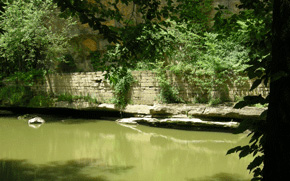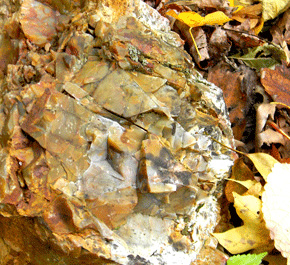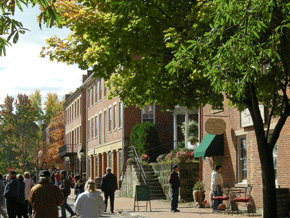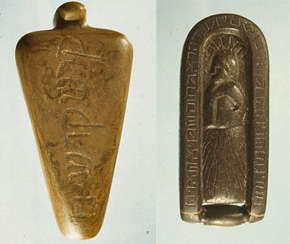
Flint Ridge
 ABOUT THE ROUTE
ABOUT THE ROUTE
East from Newark, travel via the Blackhand Gorge Nature Preserve (where an Indian petroglyph of a black hand has been destroyed, but remnants of canal towpaths, locks, and a quarry remain), to Flint Ridge – for 10,000 years the source of Ancient Ohio’s most valuable resource.
Further to the northeast is Coshocton, where the Johnson-Humrickhouse Museum displays the inauthentic but historically interesting “Newark Holy Stones;” to the south lies the Glenford Fort earthwork, and the well-preserved Zane’s Trace settlement of Somerset.

 BLACK HAND GORGE
BLACK HAND GORGE
Leaving Newark on Route 16 east will take you past a newer architectural “wonder:” the bizarre, giant Longaberger Basket, probably one of the best-executed examples of literally iconic architecture in the US. Continuing on Route 16 for a total of 11 miles, exit at State Route 146, and then immediately right on Toboso Road for two miles to Blackhand Gorge Nature Preserve.
Here, the Licking River has cut a narrow gorge through a high sandstone ridge. This unusual chasm is named after a “black hand” petroglyph, left on the cliff face here long ago, that has inspired many Native legends: one proclaimed this was the boundary of long-sacred lands, where no man could raise his “hand” against another. The river here would have been a route for Flint Ridge flint, on its way down to the earthworks at Newark, and beyond.
In 1828, this section of the river became part of the Ohio and Erie Canal. The “Black Hand” was destroyed when the stone towpath was constructed along the riverbank. Besides the Central Ohio Steam Railroad, the electric inter-urban trolley car also came through a tunnel here on its way from Zanesville to Newark, Columbus, and Indianapolis.
A high trail skirts the large quarry where “Blackhand Sandstone” was taken for many of central Ohio’s monuments.
Leaving the Gorge, continue right on Toboso Road, then south on County Road 278 for 3 miles, then jog to the right for ¼ mile along Brushy Fork Creek. Take Mulberry Road to the left across the creek and continue southward 2 ½ more miles before turning right onto Flint Ridge Road, which will bring you to Flint Ridge State Memorial.

The Central Ohio Steam Railroad cut a deep crevice through the Black Hand Ridge, now the park’s “Blackhand Trail,” stained by soot from locomotives.

A trail at Black Hand Gorge (across the river from the parking lot) leads to a nearly-intact canal lock hidden in the woods.
 FLINT RIDGE
FLINT RIDGE
Here a deposit of beautiful, hard, sharp, rainbow-colored flint lies close to the surface, where Native peoples have been mining it for thousands of years. The forested ridge-top is strewn with the water-filled pits where extraction has been taking place for millennia. A museum interprets the site, exhibits samples, and organizes public events where it is possible to watch modern expert “flintknappers” demonstrating the ancient techniques of fashioning the stone into beautiful shapes.
Flint Ridge was less than a day’s walk from Newark, and one of ancient North America’s greatest treasure sources. From its many pits, generations of Natives obtained beautiful, multicolored flint for shaping into weapons and tools, as early as 10,000 years before the nearby earthworks were built. They broke out chunks using heavy boulders and levers, then with care and skill chipped them into beautiful shapes.
An unusual building here was in use for a long time, perhaps a temple to enshrine the spirit of the place. Its thick walls surrounded visitors with precious flint. Eventually, two people were entombed in here, and the walls mounded with earth, carefully dotted with sets of flint blades.
The Newark earthworks were built on the closest flat river terrace to Flint Ridge. It may be that the earthworks were planned as a place of gathering and ceremony in connection with this natural source. Over time, visitors and trade spread Flint Ridge flint all over ancient North America.
Play video

The hiking trails at Flint Ridge display beautiful outcrops of the rainbow-colored rock, prized here for thousands of years.
Play video
Mark Welsh, of Dakota heritage, tells a traditional story of the discovery of Flint Ridge.
 COSHOCTON AND ROSCOE VILLAGE
COSHOCTON AND ROSCOE VILLAGE
Return to SR 16 and continue another 29 miles northeast along the Muskingum River to Coshocton, a capital of the Delaware (Lenape) Indians and site of early Moravian missions. Just across the river from downtown is Roscoe Village, a well preserved early 1800s canal settlement with many shops and cafés, and an interesting visitor center. Near the south end of the street is the Johnson-Humrickhouse Museum, featuring a spectacular collection of Chinese lacquer ware, dioramas of early Ohio settlement life, and also home of the still controversial “Newark Holy Stones.”

Roscoe Village’s North Whitewoman Street is lined with historic brick structures, and with crowds and food stalls during the annual (October) Apple Butter Festival.
 THE NEWARK "HOLY STONES"
THE NEWARK "HOLY STONES"
The Newark “Holy Stones” are one of the most famous scientific frauds in American history. In 1860, Newark surveyor David Wyrick “found” the first stone buried shallowly near the Octagon. The wedge-shaped stone was polished, and inscribed with some Hebrew characters. Five months later, he “found” another Hebrew-inscribed stone¸ this one encased in a stone box, in the remains of a large stone mound south of Newark. Wyrick and others declared the stones must be evidence of Israelite ancestry for the mound builders.
But the first stone was soon identified as a “key stone” used in the Masonic society’s rituals. Scholars pointed out that the Hebrew written on the second stone featured errors that only 19th century translators could have made. Scientific archaeologists have now decisively proven that the “holy stones” are fraudulent.
Perhaps more interesting is the remaining question of why Wyrick and the others would have done this. An answer may lie in a 19th century controversy over human origins. It was the time of the Civil War, and some were arguing that the peoples of Africa and the Americas were of a different species than Europeans. This view justified slavery and the taking of land from the Indians. The stones were probably meant to support the opposing idea that all people were of the same species, originating in Eden.
Despite the laudable goal of showing that the Indians were indeed human, turning them into descendants of Israelites unfortunately fed into racist myths that were popular at the time – that the sophisticated earthworks could not have been made by a non-white race.

The “Newark Holy Stones:” The Keystone (left) and Decalogue Stone (right) were “found” by David Wyrick in the Newark area (photos from Wikipedia Commons).
 SOMERSET AND ZANE'S TRACE
SOMERSET AND ZANE'S TRACE
From Flint Ridge, go south via Brownsville Road and SR 668 to Somerset. Of all the towns that developed along Zane’s Trace, tiny Somerset retains the feeling and the urban fabric of its origins as an early 19th century agricultural market town. While others like Zanesville, Lancaster and Chillicothe became more economically diversified, Somerset keeps the “Jeffersonian” ideal of an agrarian west, probably because it is situated on a high ridge far from river transportation or water power.
Settlers came here from the new United States and from Europe, especially German Rheinlanders after the Napoleonic wars. They were commercial agriculturalists, open to innovations and larger-scale operations, growing and selling crops to make money. At the turn of 1800, the fact that Ohio was “free country” also gave opportunities to poor American whites to become farm workers, which was not possible in the pre-Civil-War South because of slavery. The land was cheap, the soil was superb, people came pouring in along Zane’s Trace, and Somerset thrived.
Somerset probably contains more than thirty log structures, recognizable even through modern cladding because of their proportions and sometimes their subtle tilt. Somerset’s courthouse, on its “Pennsylvania” style town square, is one of only two surviving in the state from the once-common, first generation, pyramid-on-cube design. A second square, a couple of blocks west along the early highway and now called “Pigsfoot,” was for markets. South of town on SR 383, take the last right before the fence and pond to see the Catholic Priory of Saint Joseph, the oldest Roman Catholic church in the state.

Somerset’s Main Street, Clay Haus Restaurant in the middle on the right.
 GLENFORD FORT
GLENFORD FORT
Six miles north of Somerset lies one of Ohio’s best preserved hilltop enclosures. Although still on private land, it can be visited (inquire locally with the Historical Society of Perry County This email address is being protected from spambots. You need JavaScript enabled to view it. or at the Cooperider Farm (4265 Twp Rd 19NW, email This email address is being protected from spambots. You need JavaScript enabled to view it.). The steep, quarter-mile climb through beautiful, old-growth forest is rewarded with views of an intact, mile-long, all-stone embankment wall surrounding the level hilltop, with a stone ceremonial mound in the center. Glenford Fort is one of the best examples of a walled hilltop enclosure in the region. In the words of Norman Muller:
Glenford Fort owes its remarkable state of preservation to having been in the hands of one family for close to two hundred years. The wall is probably much the same as it looked when Caleb Atwater first laid eyes on it in 1818.

The stone enclosure walls of the Hopewell era Glenford Fort stand atop a plateau in old-growth forests.


